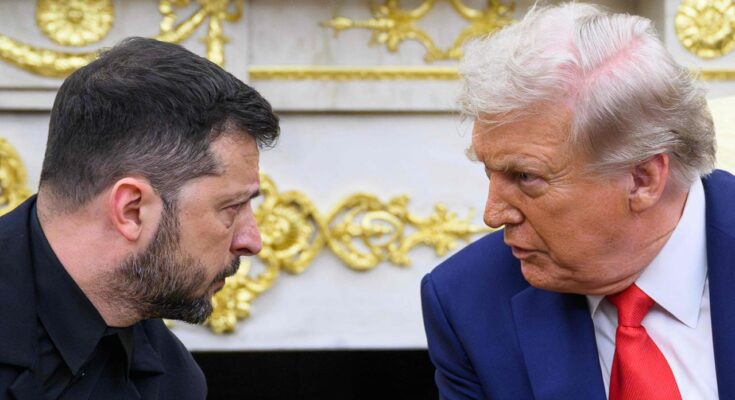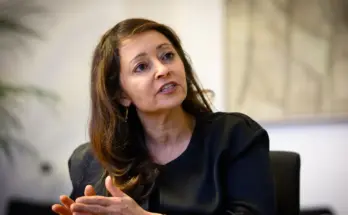general questions
No NATO membership, smaller army numbers, and surrender of territory: the US plan requires significant concessions from Ukraine. What’s in it? What are the reactions – and how to evaluate them? The most important questions at a glance.
With a plan consisting of 28 points, US President Donald Trump’s administration wants to end Russia’s war of aggression in Ukraine which has lasted for three and a half years. Several media outlets such as the US news portal Axios published the list, the contents of which were also confirmed by government representatives from the US and Ukraine.
What are the key points of the US plan?
The draft, among other things, provides for territorial concessions by Ukraine: Crimea and the Ukrainian-occupied Donetsk and Luhansk regions will be recognized de facto as belonging to Russia.
Additionally, Ukraine should constitutionally stop joining NATO. The size of the Ukrainian army should be limited to 600,000. Additionally, Ukraine must remain free of nuclear weapons. It is possible – at least theoretically – to join the EU, but given the complicated situation, this is unlikely to happen in the near future.
An American-Russian working group on security issues will ensure that the agreement is adhered to – and a “Peace Council” chaired by Trump will ensure compliance with the agreement.
When all parties have agreed to a peace plan and the military withdrawal to the agreed positions has been completed, the goal is to initiate a ceasefire. Additionally, elections will be held in Ukraine 100 days after the agreement is completed.
Which Territorial session planned?
The plan requires significant concessions to Moscow. The Donetsk and Luhansk regions, like the Crimean peninsula, “will be de facto recognized as Russian territory, including by the United States,” the draft said.
In addition, the Ukrainian army will vacate the part of Donetsk that they still control – according to the plan, this part will now be considered a demilitarized buffer zone and recognized as Russian territory.
In the southern regions of Zaporizhzhia and Kherson, the current front line will be designated as a dividing line. The Russian army must clear the bridgeheads in the Kharkiv and Sumy regions it currently occupies.
Russia will renounce any further territorial claims. Territorial issues must only be resolved peacefully, otherwise all security guarantees will be lost. The Zaporizhzhia nuclear power plant will be placed under the control of the International Atomic Energy Agency (IAEA), and the electricity generated there will be divided equally between Ukraine and Russia.
How Security guarantee for Ukraine?
In return for the concession, Ukraine was promised “reliable security guarantees” from the US, although it remains unclear what this means in practice and whether Moscow would face consequences in the event of another attack.
Russia, which started a war of aggression in violation of international law in February 2022, must renounce any further territorial claims and legally commit to stopping its aggression against Europe and Ukraine.
What else is planned?
Ukraine’s sovereignty has been confirmed. Russia, Ukraine and Europe declare the conflict over the past 30 years has ended. It was agreed not to attack each other. Russia and America are discussing nuclear weapons control again.
In its constitution, Ukraine refuses to join NATO. NATO has committed not to recognize Ukraine and not to station troops in Ukraine. European fighter jets stationed in Poland.
An international fund for the reconstruction and development of Ukraine’s infrastructure will be created. The United States in particular helped expand Ukraine’s gas industry. $100 billion in seized Russian state assets will be used for US-led reconstruction and investment efforts in Ukraine. The US receives 50 percent of possible profits.
The EU contributed $100 billion to reconstruction and released confiscated Russian assets. Remaining Russian assets should be channeled into joint investments and projects with the US, serving as an incentive not to rekindle the conflict.
Who made that plan?
According to US government spokeswoman Karoline Leavitt, the plan was developed over weeks by Secretary of State Marco Rubio and Trump’s special envoy Steve Witkoff. The two exchanged views with representatives of Russia and Ukraine to understand what each country wants to do to achieve lasting peace.
It was “a good plan, both for Russia and Ukraine,” Leavitt said. The plan is supported by US President Trump.
How will Ukraine react to the proposal?
A delegation led by Daniel Driscoll, Secretary of State at the US Department of Defense, presented the US government’s proposal on Thursday evening in Kiev. Ukrainian President Volodymyr Zelensky said in a video message afterwards: “The Americans have conveyed the points of the plan to end the war – their point of view. I have conveyed our principles.” Now we have to work on the individual points.
“We are ready for clear and honest work – Ukraine, the United States, our partners in Europe and the rest of the world,” Zelensky said. According to his office, Zelensky wants to immediately speak with Trump by telephone.
Zelenskyj said he reacted “very diplomatically”. ARD Correspondent Vassili Golod from Kiev. The president thanked each diplomatic initiative, but also explained “that Ukraine cannot be involved in everything, that there are certain principles.”
Zelensky stressed that Ukraine has always been interested in peace and Ukraine and its European partners must join in this.
What do Europeans say?
European countries were somewhat surprised by the US action and reacted with annoyance. They made it clear: the EU demands participation in possible negotiations. “For any plan to succeed, it needs Ukrainian and European support,” said EU foreign policy chief Kaja Kallas. The European community welcomed “any effort” for “long-term peace,” Kallas said. However, negotiations can only be carried out together.
Federal Foreign Minister Johann Wadephul also confirmed the involvement of Ukraine and its European supporters in the negotiations. Wadephul does not see the concept as a finished plan, but rather as a contribution to bringing the conflicting parties to the negotiating table. He basically welcomed the US initiative. But the following applies to Germany and Europe: “We support Ukraine.”
The goal is to ensure that “Ukraine can discuss these points from a strong negotiating position.” The government in Kyiv will ultimately have to decide what compromises it is willing to take. “We are not referees here, but we are defenders of Ukraine, because Ukraine defends its freedom and the freedom of Europe,” Wadephul said.
What is Russia’s reaction?
There has been no official reaction from Moscow. Yesterday, President Vladimir Putin demonstratively visited a Russian army command post and reaffirmed his commitment to the war cause while appearing in camouflage uniform. “We have a common task, our goal.”
The most important thing is to absolutely achieve the objectives of the “special military operation,” Putin was quoted as saying by the Kremlin. The head of state was informed by the generals about the advance of his troops in Ukraine.
How should the proposal be classified?
The plan is not yet officially available, reports ARD Correspondent Kerstin Klein from Washington. The White House is still keeping a low profile. But what was leaked was more like a “list of maximum Russian demands.”
The surrender of territory, the weakening of the Ukrainian military, no real security guarantees – which at first seemed one-sided. The term “peace plan” also seems a bit of a stretch – US Secretary of State Rubio called the plan “more like a list of potential ideas for possible peace” on the X platform.
Regarding the handover of Ukrainian territory required in the US plan, President Zelensky cannot make the decision himself, he explained ARD Correspondent Vassili Golod. The constitution clearly stipulates that this must be done by voting throughout Ukraine, “including the currently occupied territories.” “And we also see that there is no majority in the country that supports ceding territory to Russia.”
However, what Ukraine is prepared to do is “freeze” the current front line and then hold negotiations, Golod said. Zelensky has underscored this willingness for months, “and now it is up to Russia whether there is movement, whether Russia really wants peace.”



